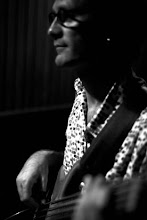 Hi there!
Hi there!
The Über-Jay Mark II hit the road one month ago. It is both a second prototype as it is a commissioned build.
The customer agreed that I will decide later whether I keep this one and build another one for him or not. It's still a prototype right? ;)
The more I play the first one the better I understand it, and now that he's finally hitting the stage I'll know him even better. The Mark II will be the by-product of this playing/building process.
The basic specs are:
4 strings. 22 frets.
Swamp Ash chambered body. Camphor Burl top. Birdseye Maple/Padauk neck. Curly Maple F/B
2 J p-ups (brand to be decided). ETS bridge. Custom made black and chrome hardware.
Here's the first round of pictures.
 The combination of Swamp Ash and Camphor Burl should enhance further the lines of
The combination of Swamp Ash and Camphor Burl should enhance further the lines of
the body. Compared to the classy black//white/gold look of the first Ü-Jay, this one will probably have more bite :->
Under the saw the Camphor Burl smells great...spicy...I think I can get high on this.
I am more concerned with the look of the back since the front will be hidden. So what you see in the picture is the back, not a left handed model.
 These are two 13/64 (5mm) slices taken from the back of each half. The lower one will be used to make a cavity cover with matching grain.
These are two 13/64 (5mm) slices taken from the back of each half. The lower one will be used to make a cavity cover with matching grain.
As you can see there isn't much left to chamber once the carving of the back is taken into account. But that's shaving off weight too, isn't it?

The chamber and the cavity are connected by a small channel to make wiring easier. At a later stage I will route a similar channel between neck p-up/chamber and bridge p-up/cavity.

The neck laminates - BE Maple and Padauk. I just love the way they complement each other and the Ash/Camphor Burl of the body
Here is the body with top glued on and - if you can see it at all - the black veneer in between. I can see it's gonna look great.

Which made me think... one subdued feature of the original Ü-J to me is the very pronounced back contour. This time around I wanted to try something different.
There you go: red veneer all over the back. It's pressure dyed and the color is really vibrant. I'd say it's Maple. Once the Ash laminate is sanded to the final shape, the red veneer will outline the contour.

BTW, you might notice that I have re-routed the cavity and reduced the neck heel further compared to the previous build.
Here's the neck roughly shaped, and the black veneer clamped to the headstock. Later I will add the Camphor burl veneer. This time around I have shaped the headstock just like the original Fender, so the veneer needs a bit of bending.


I spent the whole afternoon filling every pore of the room with fine Camphor dust. The front is almost done; The back - where the fun is - is half way through. I'll finish tomorrow.

I sanded only up to 100. This time around I'm gonna use micro mesh up to 12000 grit.
There might be more shaping to be done - mostly the lower horn scoop, the upper chest area contour and the neck heel. You should be able to see some thin red lines on the back marking how far in the contour can go without hitting the chambers.

I'm also happy with how the grain of the top matches that of the body. In fact, only where the contour is more aggressive sometimes they don't. It doesn't seem to be a bother given the presence of the red veneer. Well, to me anyway

If I taper those areas even further the grain orientation will change again. Who knows, maybe they'll end up matching perfectly.

I've worked the contour so as there is always a line running parallel on both sides of the veneer. This way there are basically three lines following the body profile and merging at the two horns tips.
This is another detail where the Mark1 and Mark2 differ. It should look quite neat with glossy finish.
I am particularly happy about the way the cover is working. If not for the marker line it would be virtually invisible. Then the line will go...

When you take out the cover this is what you're gonna see. I like adding some unexpected elements to a design. To me it keeps the experience fresh and intriguing overtime.

The jack recess I carved on the first über works very well. It protects the jack and makes it easy to find the hole when plugging in. So I'm using it on this and future builds. It works even better with this new cavity cover
The body's ready, sanded to a 180 grit. I won't go beyond that until p-ups cavities and neck pocket are routed. Unfortunately both p-ups and bridge delivery dates have been delayed due to Xmas rush.
I could work on the neck then. Wait... The CF rods haven't arrived yet... delayed due to Xmas rush... crisis? what crisis?
Ok, not everything is being delayed. I just received two new metal knobs prototypes - a small size dome shape and a new slim design, finished in both Black and Nickel Chrome plated Aluminum. I'll upload pictures next time.
New parts for the headstock anchors are being made - prototypes by end of next week - and so is the über-jay logo. Yeah...
Thanks for following
O(=<















































